Our activities
These are the past and present activities organised by the LPIYA Group:
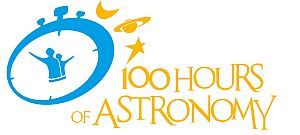
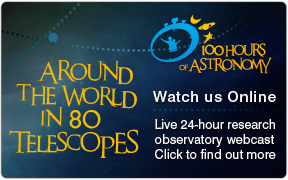
100 Hours of Astronomy
This was a 100-hour, round-the-clock, round-the-globe event that included live webcasts from research observatories,
public observing events and other activities around the world.
The LPIYA Group participated in the "Around the World in 80 Telescopes"
24-hour live event, with webcasts from the Gran Telescopio Canarias, the Swedish Solar Telescope, the Telescopio Nazionale Galileo and the
William Herschel Telescope on the night of 3/4 April 2009,
reporting on facilities and some of the sientific highlights. More information on the 100 Hours of Astronomy event can be found here:
100 Hours of Astronomy web site.
The video showing the webcast from La Palma can be downloaded from: 100 hours of astronomy, Ustream or
ESO.
We also collaborated with the initiative "100 Hours Junior" somehow, as during the days of the event we showed around a group of students (12-16 years) and teachers from the Marlborough School, UK,
who could join the observers at the William Herschel and Isaac Newton Telescopes, observed the Moon using the finder on the Jacobus Kapteyn Telescope and participated in the webcast
from the William Herschel Telescope.
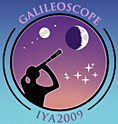
The Galileoscope
The LPIYA Group promoted the purchase and distribution of a number of Galileoscopes in every secondary
school on La Palma.

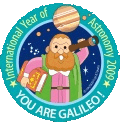
The Galileo Teacher Training Program
The LPIYA Group supports the use of the Galileoscope at the secondary schools on La Palma, including some of the material from the project
"You are Galileo!"
(Galileo Teacher Training Program). Our local project for secondary school students and teachers
"Our pupils and the Roque de los Muchachos Observatory" benefits from the material provided by this global project.
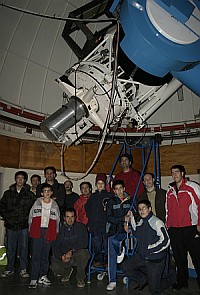

The Galilean Nights
The LPIYA Group joined the Galilean Nights 22-24 October, 2009 and invited a group of amateur observers
from La Palma to observe the Moon and Jupiter using the finder of the Jacobus Kapteyn Telescope on the night of the 23rd of October.
We went through the pages of Galileo's Sidereus Nuncius and tried to recognise the drawn features of some of the objects.

Astronomy in the streets
This Spanish initiative involved local authorities naming streets,
squares, etc. with astronomical terms. On the 14th of August, 2009, the LPIYA Group supported naming a street "Vía Láctea" (the "Milky Way") in Santo Domingo village,
head of the Garafía municipality in which the telescopes are located.

Una Universidad, Un Universo
The Spanish project "Una Universidad, Un Universo" ("One University, One Universe") aimed at giving at
least one astronomy lecture in every Spanish university, for both humanities and science students and teachers. The LPIYA Group scheduled two talks in November, 2009 to be given at the
Centro Asociado de la UNED - La Palma (UNED is the Spanish distance-learning university) in Santa Cruz de La Palma.
The given talks were: "Los grandes temas de la astrofísica actual" ("The current main topics in astrohysics", for humanities teachers and students)
and "Desarrollos actuales en instrumentación y técnicas astronómicas" ("Current astronomcial instrumental developments and strategies", for science teachers and students).

El Universo para que lo Descubras
"El Universo para que lo Descubras" ("The Universe for you to Discover")
was Spanish project partially based on the global project "From Earth to the Universe", which aimed to organise an itinerant exhibit of
astronomical images accompanied by some text from known writers. The exhibit can also be shown on a high-resolution video which will be shown during the
local exhibit "íMira qué Luna!".
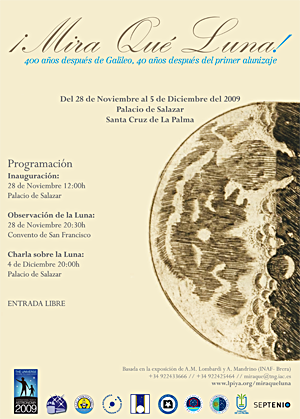
"¡Mira qué Luna!" exhibit
¡Mira qué Luna! ("Look at that Moon!") was an exhibit which took place from the 28th of November to the 5th of December 2009 in Santa Cruz de La Palma. It's about a
historical overview of Moon research and observations from 1609 to present time, including historical texts from the Brera Observatory in Italy and recent research results and images
from the Roque de los Muchachos Observatory. It consisted of panels, videos, talks, concerts, Moon observations, and even a small library dedicated to the Moon with books
from the John Whelan Library (ING). To properly focus on Galileo's work, a limited series of digitalized copies of the Sidereus Nuncius
were printed and distributed, one of them exposed to the public in the Palacio
Salazar exhibit.
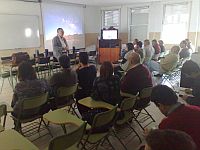
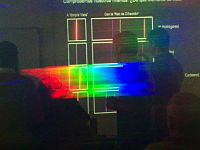
"Our Pupils and the Roque de los Muchachos Observatory"
The LPIYA Group and the schools on La Palma will work together to bring astronomy to every student aged 14-16, offering a talk,
a workshop activity and a visit to one of the telescopes, all by an astronomer working at
the Roque de los Muchachos Observatory. This own project is called "Nuestros Alumnos y el Roque de los Muchachos" ("Our Pupils and the Roque de los Muchachos Observatory"),
it starts in 2010 and it's a big joined effort of every user institution, involving more than 20 astronomers.

Naked-eye observations with Jacobus Kapteyn's finder telescope
The finder of the Jacobus Kapteyn Telescope is a refractor with an aperture of 20cm and a focal length of 3250mm.
It was refurbished by ING staff, and it is ideal for naked-eye
observations. For that reason, it has been used for public observations to commemorate the first astronomical use of the telescope by Galileo in
1609. The LPIYA Group organised a "Un Sorteo Estelar" ("A Stellar Raffle") to help those affected by
the La Palma forest fire in July, 2009. Those who won the raffle were awarded with an observing session using the JKT's finder on 29th August, 2009 and could observe the Moon, Jupiter and some
deep-sky objects, recalling those first naked-eye observations with a telescope by Galileo."












